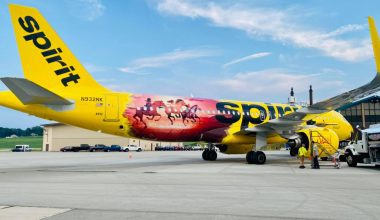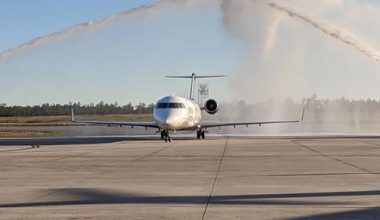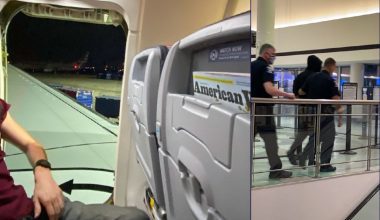Speed is the essence of an aircraft to connect continents in mere hours. What makes air travel ahead of other means of transport is its ability to cover vast distances in a very short time. Convair 990, an American narrow-body four-engined jet airliner, took the idea of going fast too seriously. Introduced in 1962, Convair 990 held high hopes of kicking the jet age to the top gear and becoming the world’s fastest subsonic aircraft. But it couldn’t live up to expectations and was deemed a commercial failure. What was the reason behind Convair 990’s failure?
This guide covers everything you need to know about Convair 990, including its design, reason for failure, specifications, etc.

Background of Convair 990
Flying was associated with glamor, luxury, and speed during the advent of the jet age. Airlines strived to fly aircraft that could make transcontinental and intercontinental travel faster and easier for their high socioeconomic class passengers. American Airlines clamored for a speedier coast-to-coast aircraft that could fly the New York-Los Angeles route non-stop and faster than the aircraft of that time.
The airline requested Convair to design a high-speed aircraft with a larger passenger capacity than the earlier 880 variants. The Convair 880 was a low-wing airliner built as a smaller yet faster competitor to Boeing 707 and Douglas DC-8. Powered by four underwing GE CJ-805 turbojets, Convair 880 could cruise at 870-990km/ hour and offer a range of 4,578km. Despite having an extra speed and impressive range, the 880 couldn’t fare better than its competitor due to low passenger capacity. The 880 was the smallest of the first-generation US jet airliners, and its five-abreast seating made the jet a tough sell to airlines. It couldn’t carry enough people for airlines to make a profit in the deployed route.
Upon request of the Texas-based aviation giant, Convair built a new jetliner designated as ‘Convair 990’.
Convair 990 design and development
Convair 990 was a major modification to the earlier 880 version, featuring more passenger capacity and speed. It was a lengthened variant of its forerunner Convair 880 and touted a length of 42.6 m against the 880 model’s 39.4m. Stretched by 3 meters (10 feet), Convair 990 could seat passenger numbers between 96 and 121. As a successor to the earlier Convair 880, Convair 990 could cruise even faster at Mach 0.84 (896km/ hr or 484 knots).
The US plane manufacturer Convair began the production of its new airliner 990 in 1961 and operated its first flight on January 24, 1961. The planemaker had promised American Airlines that the new plane would have a cruise speed of 635 miles per hour (1022km/hr). Convair fitted its new aircraft with uprated General Electric CJ-805-23cs engines to deliver on the promise.
The uprated engine was a simplified, non-afterburning civil version of the J79 and used a fan stage at the rear of the engine. Meanwhile, Convair 990’s competitors were fitted with Pratt & Whitney JT3D, which used a fan stage at the front of the engine.
Convair 990 key changes
On top of fuselage stretches and engine upgrades, the key change from the 880 included the addition of large anti-shock bodies. Anti-shock body is a pod positioned on the upper trailing edge of the wings to reduce wave drag while traveling at Mach 0.8 to 1.0 speeds. The Convair aircraft manufacturing company fitted its new airliner with large anti-shock bodies to increase the critical Mach and store additional fuel.
Expectations vs. Reality
Convair introduced myriad tweaks and improvements on its new airliner to compete against Boeing and Douglas counterparts. To give the 990 the ability to cruise at 635mph, Convair added more powerful engines, a new 39-degree wing, and large anti-shock bodies. On the drawing board, Convair 990 was the fastest subsonic aircraft but did it meet the specifications promised?
When the Convair 990 made a maiden voyage in January 1961, technical errors started to surface. The turbulence around the inboard engines impeded the effectiveness of 990’s elevators, lowering the aircraft’s cruise speed. Convair 990 encountered excessive drag problems in flight testing, so it couldn’t perform as promised. Disappointed with Convair 990’s inability to live up to its promise, American Airlines reduced its order. Instead, the Dallas Fort Worth-headquartered carrier went on to place orders for derivatives of Boeing 707.
Plagued with numerous flaws, Convair 990 failed to operate a non-stop coast-to-coast flight from New York to Los Angeles. American Airlines found little-to-no speed difference between Boeing 707 and Convair 990 regarding the flight schedule.
In attempts to push aircraft to the limits of speed, American aircraft manufacturer Convair failed to consider the efficiency. The new plane not only had to be fast but also be able to offer a certain degree of fuel efficiency. The 990 aircraft burned 6.24 tons of fuel per hour to deliver 0.84 cruise speed, which made it economically unattractive.
Convair 990A-the high-speed, long-range variant
To meet the bespoken specifications and win back American Airlines, Convair produced CV-990. The higher-speed, longer-range variant of Convair 990 fit the carrier’s expectations. Convair streamlined the engine pylon/wing interface and equipped nacelle fairings to achieve the maximum speed of 0.89 Mn.
The Convair 990 project suffered several delays as Convair was busy trying to resolve technical issues. By this time, Boeing and Douglas’ rivals came up with new versions of the DC-8 and 707. Soon, new Boeing and Douglas models started to lock up major sales and gain airline orders. The new competing prototypes offered more fuel efficiency, range, and profit than 990As. So, American Airlines started to phase out its fleet of 990As in 1967.
Fall of Convair
CV 990 was commercially unsuccessful and dealt a heavy blow to Convair’s fortune. Both its 880 and 990 projects were financially disastrous and among the lowest-selling jetliners of all time.
The Convair division of General Dynamics produced a total of 37 CV-990s over the lifetime of the production run from 1961 to 1963. The early 880 program wasn’t successful either, with only 65 units built.

Over the lifetime of 880 and 990 projects, General Dynamics lost so much money that it had to exit the jet airliner business. The company entered the jetliner business with 880 and 990 designs, failing to find a profitable niche. The CV880 wanted to compete in low passenger capacity, luxurious, speedy, medium-range market niche but failed to create demand.
The modified CV990 targeted a 96-121 passenger capacity, high cruise speed market niche, which was soon captured by Boeing 707 derivatives. CV990 was a short chapter in aviation, but it closed the chapter of Convair’s commercial airliner program forever.
Primary operators of Convair 990
The operators of Convair 990 Coronados include American Airlines, SwissAir, Alaska Airlines, Scandinavian Airlines System, NASA, Aerolineas Peruanas SA, Balair, Balkan Bulgarian Airlines, Middle Eastern Airlines, etc.
SwissAir, the national airline of Switzerland, purchased eight 990As in the early months of 1962 to serve long-distance routes. The four-engined CV-990s flew long-haul flights to South America, West Africa, the Middle and Far East, and densely-trafficked European cities under SwissAir control. The Swiss carrier phased out the fleet of Convair 990 in 1975.
Scandinavian Airlines, the flag carrier of Denmark, Norway, and Sweden, was also the operator of Convair 990 Coronado. The aircraft served the carrier’s long-haul routes to Tokyo and Far East cities. Similarly, former Peruvian flag carrier Aerolineas Peruanas also operated two Coronados from the capital city of Lima.
Several airlines like Air France, Balair, Ghana Airways, Paradise 1000, Thai Airways, etc., also operated Convair 990s on lease.
Second lease of life on charter airlines
In the late 1960s, when major airlines started retiring their Convair 990s, charter airlines flourished all over Europe and North America. Several airlines started deploying 990s on their fleet, giving them a second life on charter operations. One notable charter airline is Spantax, a Madrid-based carrier operating tourist charter flights between European and North American cities.
The Spanish carrier became 990’s largest operator by purchasing them from American Airlines and Swissair. The aircraft operated charter flights under Spantax brand until the mid-1980s.
Similarly, the Colorado-based Denver Port of Call airline operated 990s for charter service until the late1980s.
Performance specifications of Convair 990A
Powered by 4 GE CJ805-23B turbofan engines, Convair 990A touts a maximum speed of Mach 0.871 (540knots) and a cruise speed of Mach 0.84. It can carry a maximum of 149 passengers over a range of 3,302 nm. Similarly, it can accommodate four crew (+ cabin crew) at a time.
Bottom Line
Convair 990 was a feat of engineering and futuristic for its time, with an extraordinary flying speed. But, it couldn’t attract airlines due to less efficiency and economics. It was 25-35 mph faster than its rivals in cruise, but its low passenger capacity and fuel-guzzling engines overshadowed the speed capability. Although it was a commercial disaster, it was arguably ahead of its time and left a legacy of speed for years.






